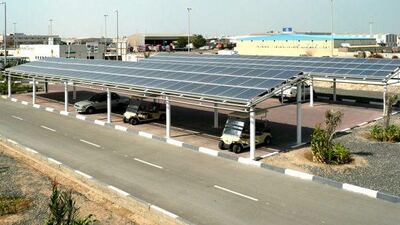ABU DHABI // Solar panels sitting on top of parking shades in Musaffah are providing answers to a puzzle the world is racing to solve: how to efficiently feed power from alternative sources into the main electricity grid. More solar panels are set to be installed on top of a city office building in the next few months, as part of the emirate's aim to have at least seven per cent of the capital's energy capacity generated from renewable sources by 2020.
The 14 photovoltaic (PV) panels in the Musaffah study, which cover an area equal to a 20-car parking area, have generated 3,756 kilowatt hours of electricity that was fed into the emirate's power grid since November. PV panels use semiconductors to turn sunlight into energy. The study, the first of its kind in the region, is being conducted by the National Energy and Water Research Centre, a subsidiary of the Abu Dhabi Water and Electricity Authority.
Dr Hamda al Thani, the director of the centre, said she was excited by the advances already made by the research project. "Since early November last year, we have been feeding the grid with clean electricity," Dr al Thani said. "This is only a start but once the project proves the concept ... We can scale up the projects and have integrated built-in design." The study will help in the drafting of rules for the use of renewable energy, along with providing research regarding the new panels, which will cover 25 square metres on the roof of the research centre's building.
Without the rules, private developers looking to equip buildings with solar power would not be able to feed the main grid with surplus electricity. Regulators and utility companies worldwide have been working to overcome the technical challenges to integrating renewable energy into power grids. One of the problems is efficiently turning the direct current (DC) power generated by a PV panel into alternating current (AC), the type delivered by the grid. The Musaffah study uses 13 inverters for that.
Ammar Munir, an engineer at the research centre's renewable energy department who is working on the project, said another example of the challenges researchers face is when the grid switches off but PV devices keep working, endangering electricians who are doing repair work. It is a difficult balancing act, as panels should work as long as possible to make full use of sunlight. "It is not logical to switch off a PV installation each time the grid is switched," Mr Munir said.
vtodorova@thenational.ae

